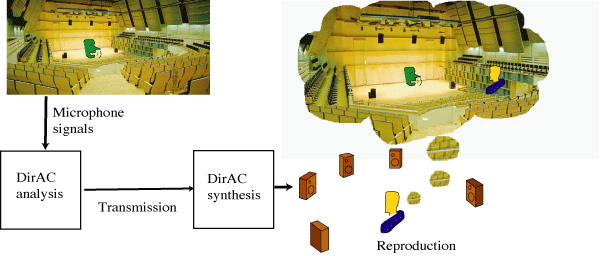http://www.acoustics.hut.fi/research/cat/DirAC/
New audio technology could revolutionize the industry
A group of scientists have developed a new audio technology in the Helsinki University of Technology (TKK). Directional audio coding (DirAC) technique aims to produce the best possible sound for the listener regardless of how many speakers the sound system has and where the speakers are located. TKK has now sold the protecting patents to a German research organization Fraunhofer-Gesellschaft.
The technique is based on Spatial Impulse Response Rendering (SIRR) and would use for example a remote control to measure and determine what kind of speaker setup surrounds the listener. By transmitting audio and metadata between the microphone, the audio system and the speakers it would produce optimal audio quality for the listener. The technology is said to be suitable for teleconferencing as well.
According to TKK DirAC could become the industry standard. The recordings would hold 1-3 channels of audio and metadata. However, the studies are not yet finished.
TKK and its researchers will continue to work on DirAC with Fraunhofer-Gesellschaft.
Source - Afterdawn.com
Seems like a good idea, but everyone has different listening tastes, what sounds good to me, might sound rubbish to you.
 |
||||||||||||||||||||||
 |

Directional audio coding |
|||||||||||||||||||||
|
Directional audio coding (DirAC) is a technique for various tasks in spatial sound reproduction. It is based on Spatial impulse response rendering, it is based on the same principles, and partly on the same methods. The processing can be divided into three steps: Analysis: the sound signals are divided into frequency bands using filterbank or STFT. The diffuseness and direction of arrival of sound at each frequency band are analyzed depending on time. Transmission: A mono channel is transmitted with directional information, or, in applications targeting for best quality, all recorded channels are transmitted. Synthesis: the sound at each frequency channel is first divided into diffuse and non-diffuse streams. The diffuse stream is then produced using method which produces maximally diffuse perception of sound, and non-diffuse stream is produced with a technique which produces as point-like perception of sound source as possible. Synthesis can be implemented in various ways, depending on microphone technique, transmission type, and reproduction system. Example applications for DirACReproduction of B-format recordings. Demos available for 5.0 loudspeaker setup. Traditionally, B-format recordings are reproduced using e.g. Ambisonics, which produces coherent loudspeaker signals. This produces blurred spatial image and small optimal listening area. In DirAC, the coherence can be avoided since in both diffuse and non-diffuse reproduction, which produces less blurring and larger listening area. 
Transmission of spatial information as side band to mono signal in teleconferencing. Demos available for 5.0 loudspeaker setup. The microphone setup is a custom B-format microphone composed of four miniature capsules. Sound is transmitted as a mono signal, with a narrow side band containing the azimuth directions for each frequency band depending on time. 
In the teleconferencing demos the application of DirAC as a new type of directional microphone for noisy recording environments. This is implemented by reproducing only the sound coming from the direction of speech source. Although the SNR decreases from 0 to -25dB, speech is still somehow intelligible, although the reproduced speech signal contains lots of distortion. Upmixing of stereo files to multichannel files. The stereophonic file is recorded with a simulated B-format microphone in simulated anechoic conditions. The sound can then be decoded to arbitrary reproduction systems. 
|
||||||||||||||||||||||
|
esittely | introduction | contact info | teaching | research | publications | current news | demonstrations | software | links | feedback | intranet | finder |
||||||||||||||||||||||
|
http://www.acoustics.hut.fi/research/cat/sirr/ |
home | |||||||||||||||||||||